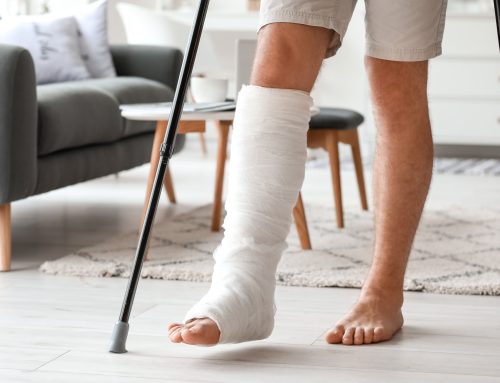You may think the worst when you hear the term stress fracture. When you put the word “stress” in front of anything, it can sound awful. Thankfully, a stress fracture isn’t as traumatizing as an impacted fracture. But, it can go undetected and easily ignored, becoming a bigger problem. When a crack occurs in the bone, there are five levels of injury, known as grades. The lower the grade, the more likely it can heal on its own and the fewer symptoms you’ll experience.

A stress fracture doesn’t typically happen from a sudden sports collision or traumatic event. Instead, they’re the result of the accumulation of bone fatigue. This type of injury is the most common in marathon runners because they subject their lower limbs to high loads. Simply put, this type of fracture can occur anywhere there is overuse.
The femur is a long bone that runs from your hip all the way down to your knee, which is why it’s one of the most commonly broken bones. Any overtraining in an endurance sport can lead to a stress fracture on the femur if preventative measures are not implemented. If you’re not careful, you may even require surgery.
Read on to learn more about the symptoms of a stress fracture on a femur, how it’s diagnosed, and treatment options.
What is a grade 3 stress fracture on a femur?
A grade 1 stress fracture on a femur might have something small show up on an imaging test but not display an apparent crack. You also won’t be in any pain at this point. A grade 3 stress fracture is when there’s marrow edema on the T1 images found in an MRI combined with pain in the area.
Think of it this way – the higher the grade, the longer the recovery time. The whole no pain, no gain mentality won’t get you very far if you overwork your bones and cause a stress fracture that puts a halt on your exercise routine.
Symptoms of a stress fracture on a femur
A stress fracture can gradually worsen because it’s often mistaken for a pulled muscle initially. However, if you push through the pain, you might notice it gets worse, to the point where you can’t even put weight on that leg.
Some common symptoms of a stress fracture include:
- Pain, swelling, or tenderness when touching your bone.
- Pain that flairs up while in use and lingers after you’ve finished that activity, i.e. dancing, walking, jogging, etc.
- Pain increases when putting weight on the leg, lifting it, or moving it.
- A dull gnawing or aching pain inside of the leg (groin area), which can even travel down to the knee.
How to diagnose a stress fracture
Your doctor may undergo a series of tests before getting to the bottom of your femur’s stress fracture. You can’t see a grade 3 stress fracture on a regular x-ray and will likely require an MRI. However, they’ll probably start with a physical exam followed by an x-ray.
An MRI is the best choice since there is no radiation exposure and is better at diagnosing different types of bone problems; however, a bone scan can also detect a stress fracture.
Treatment of a stress fracture on a femur.
Sometimes surgery is needed for stress fractures to heal properly in place. This means you might require pins, screws, or metal plates. After surgery, patients can expect to be on crutches for 2-6 weeks and be advised to take it slow for the next 3-6 months.
If surgery isn’t required, there are a few other options to support the healing process.
- Stop strenuous activity, especially if it’s causing pain. Stress fractures occur from overuse. If you’re an avid runner, taking a break for a few days may be best.
- Applying an icepack to the injured area for pain and swelling relief. You can also raise your foot above your heart (aka, lay on your back or prop up with a pillow) to reduce swelling.
- Maintaining your strength with low-impact exercises, such as swimming or biking.
- Support the injured leg’s healing process by using crutches to keep weight off it until the bones heal. While it’s still tender, it’s recommended to use protective footwear with a rigid sole that will reduce stress on your leg.
- Hands-on therapy from a physiotherapist. This could include several treatment techniques, such as stretching, trigger point releases, and more.
- Slowly introduce activities back into your routine and incorporate a lot of rest days.
- Use a LIPUS therapy device to activate cell reproduction and protein that supports healing.
Grade 3 stress fractures can go undetected but require attention before they turn into bigger problems. By introducing low-intensity pulsed ultrasound (LIPUS), you can experience faster treatment with the push of a button. Contact us to rent a device or get your own shipped to your home.
Have you ever had a stress fracture? Did you need surgery? What were your symptoms? Share your story with our readers who may be experiencing a grade 3 stress fracture.





